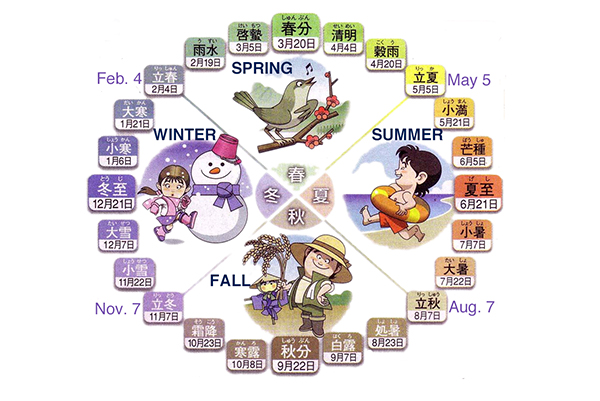The Japanese Almanac (Nijushi Sekki)
Posted by Taro Kobayashi on 17th Nov 2010

The Japanese almanac divides the year into 24 season-like periods, each lasting about two weeks.
These periods are markers of significant celestial events (such as equinoxes and solstices), weather cycles (such as monsoons) and ecological patterns (such as migrations and hibernations).
To this day the beginning of each 24 “season” is observed and marked on most Japanese calendars.
February 4 – Risshun (立春): Beginning of Spring
February 18 – Usui (雨水): Rain Water
March 5 – Keichitsu (啓蟄): Awakening of Insects (from hibernation)
March 20 – Shunbun (春分): Vernal Equinox
April 4 – Seimei (清明): Pure and Bright (skies)
April 20 – Kokuu (穀雨): Grain Rain
May 5 – Rikka (立夏): Beginning of Summer
May 21 – Shōman (小満): Little Full (new growth)
June 5 – Bōshu (芒種): Seed in Husk
June 21 – Geshi (夏至): Summer Solstice
July 7 – Shōsho (小暑): Small Heat
July 23 – Taisho (大暑): Big Heat
August 7 – Risshū (立秋): Beginning of Autumn
August 23 – Shosho (処暑): Limit of Heat
September 7 – Hakuro (白露): White Dew
September 23 – Shūbun (秋分): Autumnal Equinox
October 8 – Kanro (寒露): Cold Dew
October 23 – Sōkō (霜降): Descent of Frost
November 7 – Rittō (立冬): Beginning of Winter
November 22 – Shōsetsu (小雪): Small Snow
December 7 – Taisetsu (大雪): Big Snow
December 22 – Tōji (冬至): Winter Solstice
January 5 – Shōkan (小寒): Small Cold
January 20 – Daikan (大寒): Big Cold

